Those of you who have followed my blog for a year or more will know that we are visited in the springtime by Greylags (Anser anser). These are wild (though the books say ‘feral’) geese who arrive in February and spend the first month or so wandering about the garden and the adjoining fields eating the grass (and the farmer’s barley and wheat) and generally making themselves at home. Large family groups often stay a few hours with us before flying off somewhere else. By the end of March nesting is their priority and fewer Greylags visit and when they do they stay for longer, looking for likely nesting sites or trying to take over the prime site on the island.
Until four years ago the same pair of geese nested on the little island on our big pond and the last time they nested they produced seven goslings. They stayed with us until the young geese had learnt to fly which was great fun to watch. We were sorry to see them go but we got our garden back which was a relief. And what a mess they left behind!
The following year there was a week of fighting between ganders and at the end of it I believe the parents were eventually ousted from the nesting site on the island. Other geese nested there, and on the edge of the pond, but no goslings hatched, or if they did they didn’t survive for long. We had a couple of years of no goslings and then last year, the pair who have taken over the island had six goslings and I was able to photograph them. The parents decided to take them off elsewhere after a few days so we didn’t see how they faired.
This year the goose began sitting a little later than usual, probably because of our cold spring and I am pleased to say that two weeks ago she successfully hatched ten goslings and they have all survived so far.
Greylags appear to pair for life and the gander is very protective of his goose and stays near her all the time she is incubating her eggs. She leaves her nest twice a day to feed and the gander stands next to her while she eats very quickly. He is also an extremely protective parent and guards his offspring and protects them from predators – and gardeners with wheelbarrows and anyone wanting to walk round the garden!
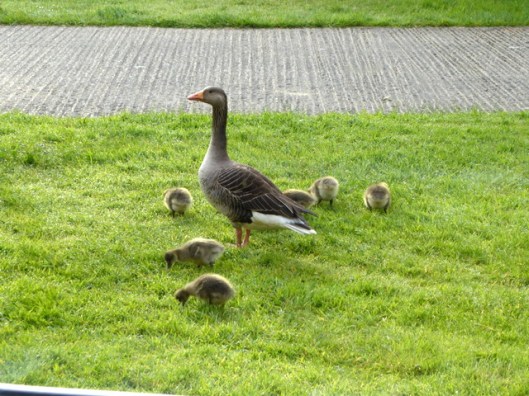
Photo taken from the kitchen window a few days ago. The goslings have more than doubled in size and their wings are growing
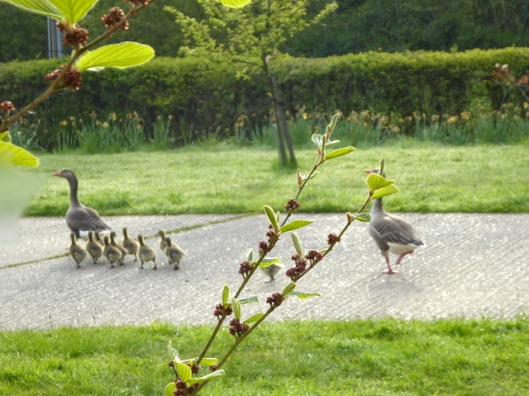
The goose in front followed by ten goslings (the tenth is obscured by a leaf) and the gander is bringing up the rear.
I have filmed them (very badly!) and I finish this post with a video of them. I used my new camera and I haven’t quite mastered filming yet! For the second and third clips I should have zoomed in much closer and the first clip of them swimming has a lot of background noise for which I apologise. As soon as I began filming some farm machinery started up. I continued filming as I might not have had another chance and I have reduced the volume considerably on the video. Living in the country is not as peaceful as you might imagine! I will try to make another and better video of them soon.
Thanks for visiting!

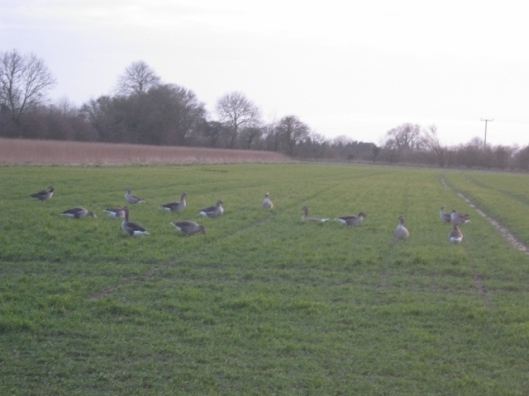


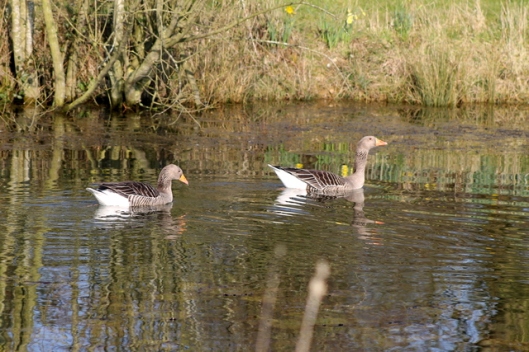
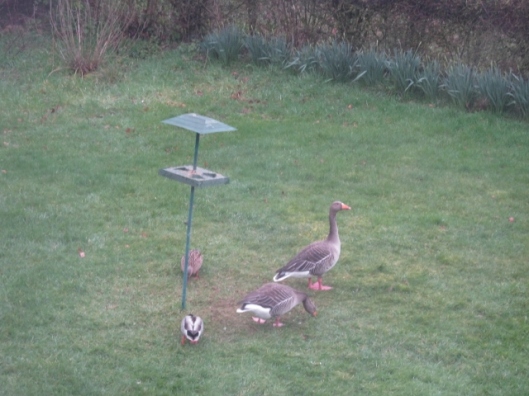
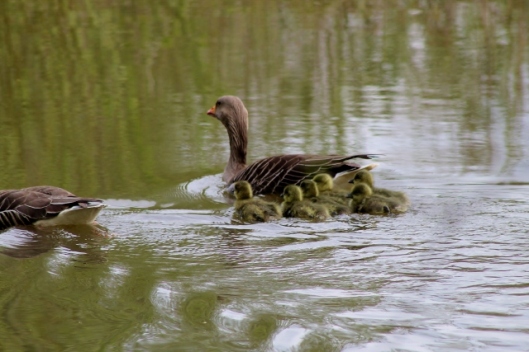




Wonderful post. I love geese, though not close up. Canada geese have attacked me before :o! Your pictures are lovely and so nice to see so many goslings :). I must admit I’ve haven’t seen many greylags before. My town and surrounding area is mostly a Canada goose zone, lol.
LikeLiked by 1 person
Thank-you C! I remember being chased by farmyard geese when I was a little girl and it has made me very cautious ever since! My parents kept geese for a while. The geese used to congregate outside the french-doors to the living room whenever the TV was on and stare at the TV and tap on the window! We have a few Canada geese round here but they don’t cause too much trouble.
LikeLiked by 2 people
It sounds like the geese wanted to get in to see the tv better, lol. Strange birds!
LikeLiked by 1 person
They are! 😀
LikeLiked by 2 people
I loved your video, Clare! I could pretend I was in England. (although it looked just like Connecticut) 🙂 What a treat for you, to be able to watch their comings and goings.
LikeLiked by 1 person
Thank-you Lisa! It is a treat for us and we count our blessings daily. I am pleased you could see the similarity in the landscape 🙂
LikeLike
The video was great and loved the procession chugging across the water at the beginning – you have a beautiful pond! I can see why they might be thought of as feral though since they look so much like the geese you might see in a farmyard.
LikeLiked by 1 person
Thank-you! They are actually the ancestors of farmyard geese and I have found them intelligent and they would be easy to domesticate I should think. The truly wild Greylags died out in the south of the UK years ago. They have been re-introduced in the south mainly in the grounds of large houses which is probably why they are regarded as feral. ‘Our’ geese have never belonged to anyone for many generations and I would call them. wild.
LikeLiked by 1 person
While I’m sure that they do leave a mess behind them, it must be wonderful to watch the goslings hatch and grow up to be adult geese! Loved the photos and the video!
LikeLiked by 1 person
Thank-you Jerry! We are so fortunate to be able to watch them grow. We really missed them for the couple of years they didn’t manage to have goslings.
LikeLiked by 1 person
They are so darling, and I love the way they just settle in and make themselves at home. In the video I hear bird song mostly, and it is charming.
LikeLiked by 1 person
Thank-you Ann. They settle in so well we now feel as though we are the visitors!
LikeLiked by 1 person
Yes, they do seem to have that attitude.
LikeLiked by 1 person
🙂
LikeLiked by 1 person
We have greylags here too in North Yorkshire just now, and I too saw my first goslings of the year late last week. Spring has sprung!
LikeLiked by 1 person
Thank-you Margaret. Yes spring has definitely sprung!
LikeLiked by 1 person
Really lovely post Clare, your goslings are gorgeous and the adults very handsome. I enjoyed your video too, something I have not tried yet, but you inspire me to get to grips with that. I could not hear the sound, but could see the footage, my monitor I am sure. Your large pond is a wonderful place for wildlife.
LikeLiked by 1 person
Thank-you Julie. I’m sorry you couldn’t hear the sound though the tractor engine is not pleasant listening! The pond is interesting all year round and we are so fortunate to have it in our garden. It needs a lot of work doing to it but we can’t do anything while the geese are there.
LikeLiked by 1 person
Very interesting, loved the family groups.
LikeLiked by 1 person
Thank-you Susan. I am very fortunate to be able to watch the geese each spring.
LikeLike
Gorgeous! I love it when birds feel like part of the family like this. When we lived in London, we had a beautiful courtyard garden with dense ivy along one wall. A number of different birds used to nest there each year – we started calling it ‘bird hotel’ in the end! And it was so wonderful watching the various chick hatch and fledge. Geese are gorgeous birds, aren’t they. Have you read William Fiennes book The Snow Geese? It is a gorgeous masterpiece 🙂 https://www.amazon.co.uk/Snow-Geese-Picador-Classic-ebook/dp/B00M4408HU/ref=sr_1_1?s=books&ie=UTF8&qid=1462958689&sr=1-1&keywords=the+snow+geese
LikeLiked by 1 person
Thank-you very much Liz! I haven’t read the book though I have heard of it. Thanks for the link I have added the book to my wish-list! Your ‘bird hotel’ sounds wonderful!
LikeLiked by 1 person
I enjoyed the video, as well as the photos and words of course. It’s wonderful to see a family so close up being natural and comfortable in their surroundings. It’s yet another reason why I envy you your garden.
LikeLiked by 1 person
Thank-you Ste. I have wanted a garden like this all my life and 10 years ago I got my wish. I am very fortunate.
LikeLiked by 1 person
This is such fun! It’s really neat that they just settle in and you can watch as they live their lives. We have hundreds (thousands?) of snow geese that come through here in late autumn and live on the lake and in the fields but i never get this close to them. It might be just as well, I would probably end up obsessed about the well-being of the babies . . .
LikeLiked by 1 person
It is very easy to get obsessed about the babies and we have seen some nasty sights over the years with moorhen chicks and ducklings being attacked and taken by predators ( though not goslings so far..) We are very lucky to be allowed to share the geese’s garden (it isn’t ours while they are living in it!)
LikeLike
What great pictures, Clare! You’re right, they do leave a mess, but the goslings are just so cute. I loved the video…fast little swimmers! Thanks for sharing!
LikeLiked by 1 person
Thank-you so much Jill. I love the goslings but they are growing so fast. They look like small geese rather than fluffy babies now.
LikeLiked by 1 person
They look far more interesting than the Canadian geese that wander my areas. The ones over here are straight assholes. Thanks for sharing 🙂
LikeLiked by 1 person
There are a few Canada Geese on a pond near us but they haven’t visited us yet I am glad to say.
LikeLiked by 1 person
Good, keep those jerks away. 😉
LikeLiked by 1 person
🙂
LikeLike
Your gees family is so sweet. Love the video.
LikeLiked by 1 person
Thank-you so much!
LikeLiked by 1 person
The young ones are cute! I hope there aren’t any predators about.
You’re lucky to have ponds. The birdsong around them is beautiful, but I don’t know how you stand that machinery. Maybe it just seems louder on the video.
LikeLiked by 1 person
Thank-you Allen. The farm-yard is just a few yards away from us and at certain times of the year it does get a bit noisy. I think the noise was from a telehandler tractor driving out of the yard and along the lane parallel with our garden. I just timed the filming badly! It can be very quiet here with just the birdsong and the wind to listen to. There are plenty of predators about – mink, otters, stoats and foxes as well as birds of prey.
LikeLiked by 1 person
I grew up helping in hay fields so I don’t mind the sound of a tractor. I didn’t know that was what it was.
I hope the predators find something other than goslings to feed on.
LikeLiked by 1 person
Those small tractors have such a high-pitched engine sound – I find them unpleasant to listen to. I don’t mind the larger tractors either.
LikeLiked by 1 person
What a treat to have your own private goosery.
LikeLiked by 1 person
We are blessed. 😉
LikeLike
Beautiful geese! Oh and the babies! How lovely it must be to see them in person! Thank you for sharing.
LikeLiked by 1 person
Thank-you very much! They are growing fast and are so fat now!
LikeLiked by 1 person
Such beautiful goose family photos, Clare! We have Canada geese here. They don’t hang around the farm, but I often hear them overhead, headed for the Santiam River and Foster Lake.
A busy week here, so I am just catching up with you all again. Cloud, wind and rain today, so I can catch up with indoor activities.
LikeLiked by 1 person
Thank-you Lavinia! We get a few Canada Geese flying over too but they don’t visit our garden. Rainy days can be useful sometimes – a good excuse to stay indoors!
LikeLiked by 1 person
Oh, Clare! This is all so interesting, and the video and photos of them on the pond are a delight. At first I wondered if these were Canada Geese, but methinks the Greylags are more handsome birds than our big pesky geese. For some reason, too, it warms me heart to hear about the birds that mate for life, As I see our resident pair of morning doves, and how close they are to each other, I keep hoping they both stay safe. Great post, thank you!
LikeLiked by 1 person
My pleasure Cynthia and thank-you. The geese are doing very well and the goslings are very big now. Richard scared them yesterday when he mowed the lawn but they weren’t hurt and are still here. We were in danger of being lost in a sea of grass!
LikeLiked by 1 person
Dear Clare… I watched the video… I think it is a very good one, so don´t say that you filmed those ducks badly cause you didn´t … I loved listening to the birds singing too and the majestic greenery all around… 🍀
Love the photographs too… Great post.. Sending love and best wishes, always. Aquileana ⭐
LikeLiked by 1 person
Thank-you so much dear Aquileana! You are very kind. Love and best wishes to you. Clare xx
LikeLiked by 1 person
This was so much fun to see Clare and I think you did a wonderful job of the video! I loved hearing all the British birds singing too. It must be wonderful to welcome these geese back each year. It was very interesting about the male being so attentive and protective – in the video was that the male following the goslings in the pond? He certainly looked like a very concerned parent – almost as if he was hurrying them along!
LikeLiked by 1 person
Thank-you Kate. I like the idea of birds being faithful to each other and to a nest site. Yes, the female is in front and the male protects from the rear. I love having them in the garden and watching their progress but the garden suffers. They trample all over flower beds and will try certain plants to see if they’ll like to eat them. Fortunately, they don’t enjoy anything as much as grass! They don’t cause as much damage as chickens; our neighbours’ flock got into our garden again today and scraped all the bark mulch away from the shrubs and trees onto the lawn, made dust baths in a new flower-bed my husband had just created and took all the new leaves off the dahlias that had just started growing! Husband is not pleased!
LikeLiked by 1 person
Oh goodness what naughty chickens!! I understand why your husband would not be pleased!
LikeLiked by 1 person
When I saw the geese waddling along it made me think of The Aristocats one of my favourite Disney films.
LikeLiked by 1 person
Oh yes! 😀
LikeLike
After a long absence i browsed around happily!! And than ending with this delightful post,bliss! xoxox Johanna
LikeLiked by 2 people
Thank-you Johanna! So nice to see you again! I hope you’ve had a good break from blogging xx
LikeLike
hy my name Chintya, i from Indonesia
foolow and follback my blog ,thanks
LikeLike
Hi Chintya! Thank-you very much for visiting my blog and for the follow. I will be visiting your blog later.
LikeLike
What wonderful natural sights and sounds. The sea is so restful with the water and the bird calls. Loved the video too.
LikeLike
Thank-you very much Vicki! I find it very soothing to be out near the pond.
LikeLiked by 1 person
How wonderful to have some wild ones visit and then stay and reproduce!
LikeLike